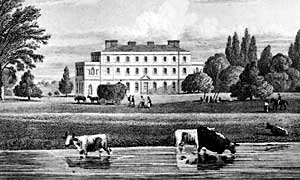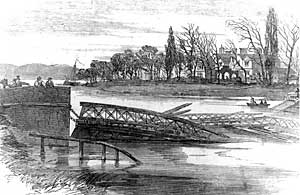Notts village in which Stuart king surrendered
A King's Prison.
In the first half of the 16th century the piecemeal sale of the Kelham family estate commenced, a process which culminated in the disposal of their manor house to John Robertson in Elizabethan times. The Kelhams had apparently removed to Clerkenwell. It was probably this mansion in which, in 1646, Charles I spent the earliest days of his captivity.
Under Henry VIII local land was still being given to chantries. Robt. Brown, of Newark, lessee of the Kelham tolls, gave Kersall manor and property here to Brasenose College, Oxford, for obits or for the college itself, if obits were not allowed, and in 1541, when the dissolution of the monasteries was just completed, John Meering left "lands, medues and howses" here, and at Newark, for a priest to celebrate for his soul in Newark Church every "Sunday, Tuysday and Thursday."
Reformation Changes.
Rufford Abbey was suppressed in 1537 and its Kelham possessions were granted with the abbey itself to the Earl of Shrewsbury. Welbeck Abbey's rental of £3 0s. 2d. was sold with that abbey to Richard Whalley, who soon had to dispose of much of his grant. Felley Priory lost its yearly rent of 6s. 8d. and the lands of the vicars choral of Southwell were sold "for ready money" to two merchant tailors of London. The portion of tithes belonging to the Southwell Chapter were also sold off, and when Queen Mary restored to the Minster its possessions, they were promptly leased out.
Edward Burnell, of Sibthorpe, who died in 1588, bequeathed to Miles Wynne "the tithe corn and hay here, commonly called the third sheaf, with the house here, which the testator held of Southwell chapter for 19 years." Mr Wynne was to pay his executors £6 13s 4d. annually for the same. A sidelight upon social conditions is afforded by a record of 1583 that the churchwardens and others were to "appoynt the parishioners their places in the Church before Sunday next." The allotment of seats was a common custom and fruitful of discontents.
Another custom of the time was the appointment of village watchmen. All able men of the parish had to take their turn in this unpaid duty from sunset to sunrise, their task being to prevent the passage through the village of "divers wanderers, evildoers and suspicious persons." In 1603, the inhabitants were brought to book for failing to provide these unwilling police. The population then was 280.
In 1552, the advowson of the rectory had been granted to Lord Clinton and Saye. In 1566, Nottingham and Newark were at loggerheads respecting the violation of the toll bridge, which was in such evil state that, three years later, men were licensed to beg alms for its repair. Under James I, many of the inhabitants, including Suttons and other prominent owners, were prosecuted as recusants for non-attendance at church.
It was reported in 1638 that the church itself was disordered: "The middle bell wantes a wheele, and the font wantes a decent cover, there wantes the books of homilyes and a booke for the names of strainge preachers; the ile neare the minister's seate wantes paveinge or boarding underfoote, the Minister wantes a hood and the Northside of the Churchyard wantes fenceing," but even so it was better off than many neighbouring churches. The village was inevitably and deeply involved in the Civil War which broke out in 1642. Many of its chief inhabitants, including the Suttons, were fervent royalists whose properties were seized by the Parliamentary troops quartered here during the sieges of Newark. The church doors still display the holes pierced in them for the muskets of defenders. In 1644, mounted troops sallied out from Newark to destroy the bridges at Muskham and Kelham, but failed to do so and revenged themselves by carrying off 60 oxen and 100 horses here and at Averham.
The Captive King.
It was to Kelham that King Charles came on May 5th, 1646, after dining at Southwell, to make his formal surrender to the Scots at the head-quarters of their general in the fields across the Trent. He expected better treatment from them than from the English besiegers of Newark for whom the Scots had no love, but he was most closely guarded in a mansion which could not have been Kelham Hall but may well have been the manor-house of his loyal supporter, Robert Sutton, who for his valour was created Earl of Lexington and to the investing army was known as " the Devil of Newark."
It was from thence that he wrote ordering the surrender of Newark, and thence, on May 8th, he was led away captive in such haste that the barber, who had been called in to trim his hair, was forgotten and carried off to Newcastle to perform his task there.
How the Scots finally handed Charles over to the English Parliament for £40,000, and how he came to be beheaded in 1649, belongs not to this local story, though it may here be mentioned that the Victorian squire of Bleasby, a descendant of the dashing Sir Marmaduke Langdale, changed his patronymic from Langdale to Kelham.
After The War.
Lord Lexington's estates were sequestrated, to be recovered by a fine, but his Averham mansion was burnt down. In 1659, a Puritan rector was installed in the living, but by 1676, the parish had a Church of England rector, who reported 135 adults in the parish and (somewhat questionably) no recusants. By that time the parishioners had been compelled by law to expend £100 upon repairs to the bridge, and Lord Lexington had purchased the Robertson estate, and was lord of the manor and principal owner here. About that time Kelham Hall was erected, and it may have been the structure described in 1697 as "a very pretty new house of brick building, of the Lord Lexington's, with walls and towers, that looks very well." The Hall was burnt down in the time of William III, re built, suffered a similar fate in 1857.
Hanoverian Kelham.

Kelham Hall in 1830.
The enclosure probably took place before 1700, and upon the death of the second Lord Lexington in 1723, his estate passed to his daughter,the Duchess of Rutland, for life, to descend to her second son, Lord Robert Manners, who adopted the name and arms of Sutton. The Rutland MSS contain a description of Keham House and its contents at that date, and tell that the warrior Marquis of Granby had of late occupied it. The Duchess, who died in 1734, erected a charity school and the Manners-Suttons made the Hall their home until far into the reign of George III.
A famous soldier who visited the Hall was the Duke of Cumberland, who, according to Stukeley, "was very fond of Lord Robert Manners who behaved incomparably at Culloden Field." 'Tis reported that he killed no less than nine Highlanders with his own hand. . . . His Highness' dined at Kelham on August 1st, 1746, on his way back from his campaign, and " drank very freely there."
In 1786, it was found that some unknown person had left £25 for the parish poor; it was then yielding 22s. 6d. a year, a sum which by 1828 had increased to 25s. distributed at Christmas. Torrington in 1789 described the Hall as "a staring ill-sashed long-windowed thing, much too near the water."
It had recently been occupied by the Earl of Lincoln, but was then let to Mr. Girardot, but in 1812 the family resumed residence within its walls. In 1828 it was the seat of Mrs. Manners-Sutton who was paying £40 a year in taxes for the 150 windows of the house.
The Church.
The small church is notable for its exquisite proportions and as an example of the last phase of mediaeval Gothic architecture. Built about 1475 it was restored in 1844 and again in 1873 when a gallery and the old box-pews were swept away. It retains its beautifully carved oak screen of 1475 and though its loft has gone, the roodstairs remain in their turret. There is a parclose screen of about 1440, a venerable roof covers the north aisle; fragments of old stained glass, a hagioscope, an iron-clamped almsbox and some other vestiges of antiquity have been spared and there are Lexington and other memorials of interest.
Modern Progress.

Kelham bridge destroyed by flooding in 1855.
In 1839 the tithes were commuted for £1,274 and in 1846 the construction of the Midland Railway necessitated the erection of a bridge to cross the Trent. In 1855 the quaint old timber bridge was destroyed by a great flood, and two years later, the hall was destroyed by fire. It was replaced by the noble structure which since 1903 has served as the home of the Anglican community known as the Kelham Fathers.
The present century opened with a population of 227, a number now increased to about 800 owing to recent developments. In 1908-12, deep borings near the railway bridge revealed underlying coal and the borings in 1917 disclosed the presence of oil. In 1919, the sugar-beet industry was inaugurated, 5,000 acres of land hereabouts being purchased for the purpose at a cost of about £500,000 towards which the Treasury contributed £125,000. The sugar factory was opened in 1921.
